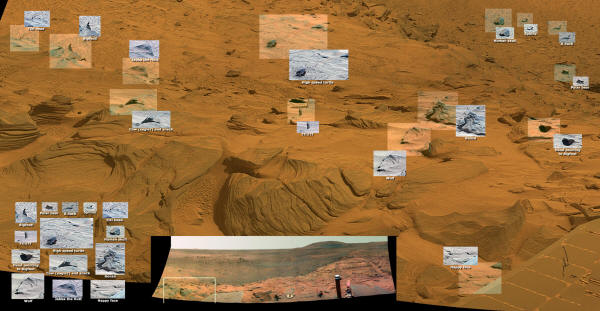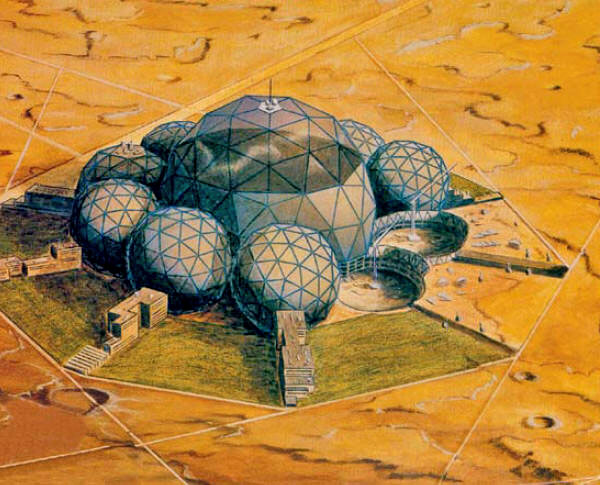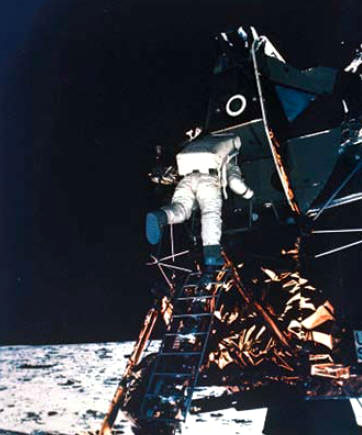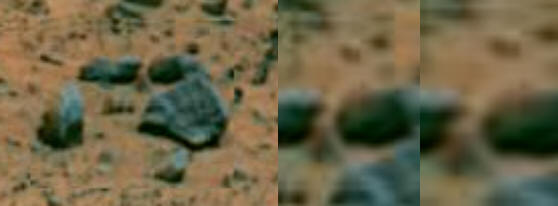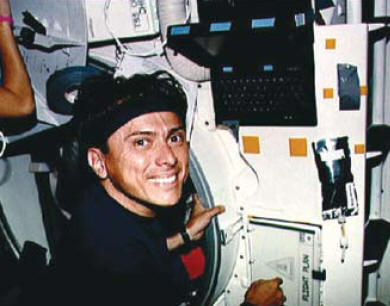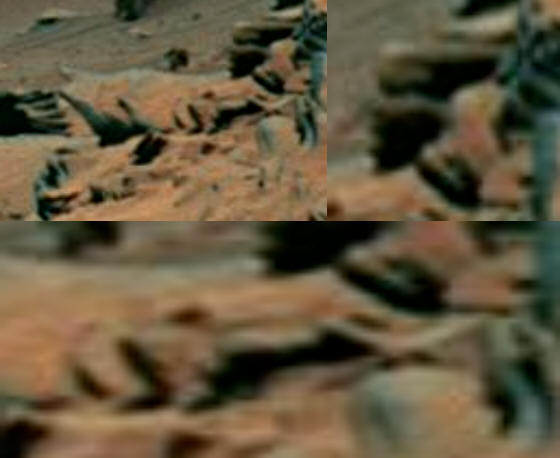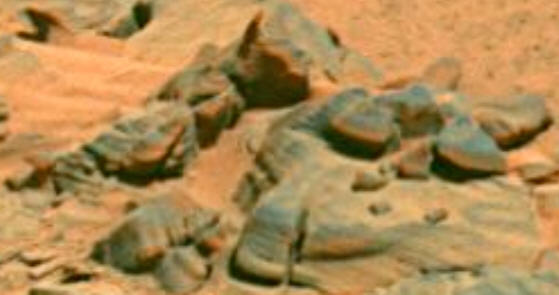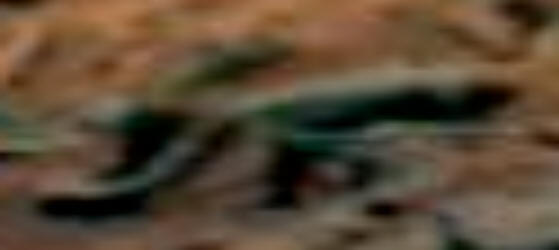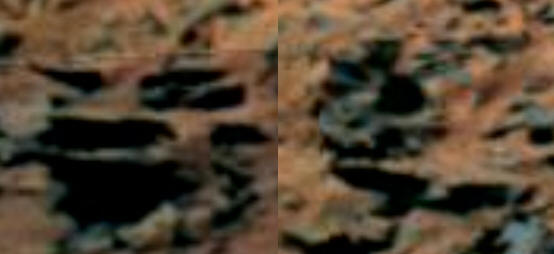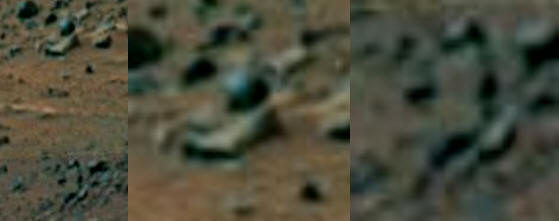|
President Mars Anomaly Research Society December 12, 2008 from ExopoliticsBlogs Website
ABSTRACT
Evidence that the Red Planet harbors life and has for eons was discovered by the author by examining NASA photograph PIA10214, a westward view of the West Valley of the Columbia Basin in the Gusev Crater that was taken by the Mars Exploration Rover Spirit in November 2007 and beamed back to the Earth.
This photograph has been the subject of public speculation since January 2008, when what appeared to be the figure of a human female was found jutting from the edge of a plateau. The figure was quickly dismissed as a natural rock formation produced by wind, water, and time, but the author and other researchers in the Mars anomaly research community believed that it was either a statue or the fossilized remains of a humanoid being on Mars.
Intrigued by this anomaly, the author subjected PIA10214 to further photo-analytic scrutiny and discovered that the photograph contains other images of human and animal life forms that constitute the first evidence of life on Mars.
In this paper, the author presents his initial data related to his discovery of life on Mars in PIA10214 in five areas, namely,
The life on Mars consists of intelligent, bipedal hominids capable of carving statues and building structures and a variety of animal species that exist, that once existed, or that have never existed on Earth.
Reptilian species predominate. He also addresses frightening content and definitional constraints that individuals in Mars anomaly research confront when evaluating this first view by human civilization of life forms and ancient artifacts on another planet.
He concludes that the discovery of life
on Mars marks an epochal moment in human history when for the first
time human beings from Earth have encountered biological organisms
living elsewhere in
the Cosmos.
INTRODUCTION
The evidence of this discovery is contained in a photograph of the Martian surface that was taken by NASA’s Mars Exploration Rover Spirit during November 6-9, 2007 and beamed back to Earth.
The number assigned to the photograph by NASA-JPL was PIA10214 (below images - large files).
This photograph is a panoramic montage of a series of photographs taken by the Rover Spirit from November 6th to 9th, 2007.
At the time that it was taken, the Spirit was perched near the western edge of the plateau called Home Plate in the inner basin of the Columbia Hills range inside Gusev Crater.
The photograph is a westward view of the surface of Mars, with the southwest on the left and the northeast on the right. At the bottom of the photograph, the solar panels of Spirit can be seen. In the foreground, the western edge of the Home Plate plateau is prominent, lighter in color than more distant parts of the terrain.
The rocky foothill in the middle
distance across the left third of the image NASA identifies as
Tsiolkovski Ridge, which NASA estimates is about 100 feet from the
edge of the plateau and about 100 feet across.
The figures were quickly dismissed as a natural rock formation resulting from erosion by wind, water, and time, despite the fact that two distinct human forms were present and gender differentiation seemed to be indicated in the form the anomalies took. The author, founder and president of the Mars Anomaly Research Society, thought that these enigmatic forms looked like a statue, or the fossilized remains of Martians fleeing a cataclysm, like a deluge, a mudslide, or a volcanic eruption, or a monument sculpted to memorialize such an apocalyptic event.
If the figures on the plateau were
artificial, then the valley below might also contain evidence that
Mars is – or once was – inhabited.
Creatures with human heads and the alpine complexion of Europeans dot both Tsiolkovski Ridge and The Turquoise Field.
In a third area of the valley, one named
by the author The Rock Garden, humanoid beings in blue
bodysuits can be seen with hand-held devices that may be technical
or musical instruments. The life forms and artifacts encompassed by
these landmarks startle the imagination, evoking a surreal landscape
by the mediaeval artist Hieronymus Bosch.
The taxonomy of some of the animals seen in some parts of the photograph is so bizarre that in some cases it is difficult for observers to even recognize them, so that the keen observer finds himself cast in the role of the aboriginal shaman, who could not only see the arrival of the Spanish ships that others could not see but discern that they were not sea monsters.
If one looks closely, then one can see creatures on Mars with the head and torso of humans and the body of caterpillars moving across the sear Martian landscape. In other parts of the photograph, higher order beings with transparent, translucent, or bioluminescent bodies have been detected that await further photographic analysis.
To see what is in these photographs, one
must view what one has never seen before and see it.
Giant grotesque heads exist in several
places (including The Rock Garden) that are either the skulls of
large, dead hominids or sculptures designed to resemble demonic
entities, with head and hands rising from below to devour or bury
those on the Martian surface.
There is evidence of extensive
digging into the Martian soil.
This cataclysm may have been the destruction of the planet Maldek, which created the asteroid belt and pummeled Mars so that it was squeezed into an oblate spheroid and fractured. The region photographed may be a nature reserve, a fossil dig at a paleological site, or a memorial park related to this cataclysm and the veneration of the fossilized remains present in situ.
By the very nature of this photograph as
the first human look at an alien civilization, the variety of life
forms, activities and artifacts are so esoteric that the entire
content and purport of the otherworldly montage defies complete
description and proper categorization at this time.
Mars, the Red Planet, which every two years supplants Venus as the planet closest to Earth, is inhabited with other biological life forms, and shows evidence of having been inhabited for eons.
In this paper, the author analyzes this first view of Martian ecology and civilization, and endeavors to present his preliminary findings related to the discovery of life on Mars in the form of:
DNA seems to have taken different evolutionary forms under the unique selection pressures of Mars.
These figures were found by many
researchers and widely reported in January 2008, when NASA posted
PIA10214 on the World Wide Web. They were debunked at the time as a
natural rock formation.
They are probably a statue of some kind.
Examining the far right side of the photograph, the author discovered several beings in blue bodysuits (left) sitting in a rock cluster he named The Rock Garden. The humanoids may be holding hand-held devices.
One, sitting demurely as if female, has
multiple arms, like a centipede. They have bulbous heads and
elongated bodies, as if “extraterrestrial.”
This skull may be the fossilized head of a giant primate in Martian history or simply the statue of a demon.
In front of the skull sits another bald-headed Martian (center).
He is sitting as if clutched in the
right hand of the statue behind him. He is holding his hand to his
mouth. Farther to the right, a bald Martian with a bigger head and
body seems to be throwing something. A female being with multiple
arms sits on the ground behind a transparent pane (right).
This is The Rock Garden.
The Rock Garden is significant because in this one small area of this vast photograph, multiple mutually corroborating forms of evidence of life on Mars have been found.
These include the presence of
intelligent, bipedal hominid creatures not unlike Homo sapiens;
technical gadgetry; social interaction; and terra-forming of the
Martian surface.
Find the square in the upper left corner
of the left solar array of Spirit, count five solar panels to the
right on the edge of the array facing the valley, and proceed
straight up the photograph. The C-shaped formation on the ridge is
blue-gray in color. The humanoid is kneeling inside the enclosure of
rocks. He is tiny and thin, like a praying mantis hatchling. He is
interacting with other humanoids just beyond the rocks.
This being has a transparent or translucent body that has not been photographed with the same clarity and opaqueness that the other being’s body has, presumably because her body is not made of protoplasm.
The humanoid in The Rock Enclosure on Tsiolkovski Ridge is surrounded by other anomalous beings.
To his right on the hillside, bald humanoids in blue clothing are sitting on the hillside (left). Up the hill, other beings are standing behind a large rock shaped into the face of a rabbit, gerbil or similar small animal (right).
Other humanoid beings can be seen standing in apertures in the soil among statues of huge heads (bottom).
On Mars, humanoids and plesiosaurs extinct on Earth co-exist (left), as snakes slither across the ground and a humanoid confronts an odd entity with a cobra-like torso (right). The Martians have adorned the surface above their subterranean dwellings with relics.
Is this an ecosystem teeming with life or a surreal sculpture garden?
Probably, it is both.
There stands a tall, semi-transparent
being with multiple, asymmetrical appendages (below). His body type
is like a Native American totem pole on Earth made entirely of
transparent glass.
If, however, he is an entity, then we can conclude that some Martians are friendly and have taken delight in the fact that we have landed Spirit on their planet.
The combination of opaque humanoids dressed in blue clothing and transparent beings with many arms can also be found in the vicinity of The Turquoise Field.
There, a corpulent humanoid dressed in a
blue gown, cape, or caftan can be seen furiously digging a hole or
descending a tunnel, as several of the glassine mantises stand
nearby (below).
Definitive biological classification will result from improved photo-analysis and study.
He has a horn on his head and is looking towards Spirit.
This may be the head of a living
organism or an artificial structure. Its facial features are
cartoonish, in the way that the façade of a ride at an amusement
park is here on Earth. Its features have inspired the author to name
it Mister Potato Head. Next to it sits a Fun Balloon Animal. Their
form and proximity to the water suggest a theme park or resort.
The clownish features of the one and roller coaster-like tubes enveloping the other suggest that these are built structures in the nature of amusement parks and not humanoids, but their human shape invites one to consider a universe of possibilities.
The very roundness of the features of these figures is similar to beings seen elsewhere in the photograph.
We can include among these oblate
humanoids the figure crawling like a baby on the far leftward edge
of The Turquoise Field (left) and the figure to her right in the
photo that resembles an astronaut buried in the sands of Mars that
time forgot (right).
The message is apt when one considers the rudimentary structure and function of Spirit:
Throughout the photograph, the beings with bald, bulbous heads can be seen interacting with a variety of species.
On a hillside beneath the mountain ridge in the far upper right quadrant, two of them sit in the Lotus position surrounded by animal species which resemble the penguin and ibis-like figures found in Egyptian hieroglyphics (below).
In one scene from The Turquoise Field (left), many humanoids, as well as an elephant-like creature, can be seen sitting around a table.
Surrounding the table are many colorful, glassine statues evocative of the style of the Spanish architect Antoni Gaudi. The transparent matrix in which they sit is icicle-like, multi-colored, and exquisitely artful.
One of the statues (center) resembles the statue of a head on Tsiolkovski Ridge (right).
This kind of round table built around ornate glasswork is present at another location near The Lake, where the Martians have designed a complex, interwoven, glassine structure embodying the heads and torsos of different beings.
The faces of adjacent beings are complementary in the manner of Pablo Picasso and executed in dreamy, pastel forms reminiscent of Marc Chagall (right).
This is art created by a high order of intelligence.
Similar glass artwork can be seen on a hill above The Turquoise Field (below).
One, in the center of the hill, has a cheerful smile on its face like The Little Engine That Could. Another, to the right in the image below, resembles the kachina dolls that exist in the western Pueblo cosmology and religious practices of the Hopi.
It is almost transparent, but one can see that it is carrying a smaller person grasping a cruciform object.
From this initial anthropological
evidence provided by NASA, we can preliminarily conclude that the
humanoid beings on Mars are sentient, possess a sense of humor and a
love of laughter, cultivate the transcendental, spiritual side of
life, and make decisions (or at least convene regularly) in some
form of communitarian social organization.
This evidence that we can gather from Spirit confirms the remote viewing data that the Martians present no threat to Earth.
Presumably, these animals subsist on
little or no water or water gathered from subterranean aquifers,
because the only water visible in the entire panorama of Mars seen
in PIA10214 is in The Lake, the azure pond below Husband Hill in the
far distance.
Until the anatomy of these creatures is understood, this methodology will have to suffice.
This category includes elephants, platypuses, horses, cows, frogs, turtles, snakes, slugs, and snails. Some of these look to be living organisms, while others seem merely statues.
What is significant is their incredible similarity to animal species found on Earth.
This category is exemplified by one species on Mars (below) that combines the bodily shape of an octopus with the face of a lion or a dog.
In this category, we can cite the
plesiosaur, which has been proposed as a solution to the Loch Ness,
Lake Champlain, and Lake Okanagan mysteries. The plesiosaur on Mars
resembles the dinosaur brachiosaurus or a long-necked tortoise.
The one at right (bottom), from The Turquoise Field, may be a statue of two Martians riding one.
The author has given these relatively inert human-reptile hybrids the name The Gumby Lizard.
Reptilian and serpent motifs jut from the bowls that ring The Rock Garden to the left of The Grotesque Skull. One resembles a snake (left), the other a brachiosaur (center).
Beneath the snake that emerges from the basin, a Gumby Lizard can be seen crawling on the rim of the basin. It resembles a toddler with the lower body of a lizard.
A being standing in the center of the garden (right) also possesses both hominid and reptoid traits.
In front of The Rock Garden, below where the humanoids sit, three filamentous creatures are walking toward Spirit.
This species, named The Woofy by the author, combines the morphology of a sea sponge with the face of a dog (Canis lupus familiaris), and would be mistaken for a sagebrush or tumbleweed on Earth, were it not for its puppy dog face.
These and other animals on Mars defy classification by any known system on Earth.
We would include among the new forms of fauna on Mars the animal whose giraffe-like head can be seen peering from behind the cliff literally within feet of Spirit. This animal has red lips, a patch of blue beneath its bulging eyes, and a crest atop its head like some dinosaurs.
Even the most spirited disinformation that this report will inspire will have difficulty finding a mundane, non-biological explanation for The Spying Giraffe (below).
These include reptiles that once existed on Earth and reptiles that have never existed on Earth. Among these species, the plesiosaur seems to be very common.
According to Wikipedia:
Maybe the creatures seen – including both living plesiosaurs (left) and dead ones (right)– are plesiosaurs that survived on Mars the extinction that befell plesiosaurs on Earth.
The reptilian species on Mars seem to be more evolved than reptiles on Earth.
In one scene from the photograph, three turquoise creatures lie tangled on a hillside (left). One has the head and shoulders of a man but his lower body is snake-like (right). Heis arching his back onto the back of a turtle and looking toward Spirit.
They seem to be more sentient and intelligent than any reptile or amphibian one would find on Earth.
These include the human figures on the
left edge of the western side of the Home Base plateau whose
discovery in 2008 led to the discovery of life on Mars later that
year; the myriad of heads that litter Tsiolkovski Ridge; and other
statues found along the jagged edge of the cliff.
The third is bas reliefs on the sides of rocks like Native American petro glyphs or the sides of hills like Britain’s Cerne Abbas Giant.
It was first theorized that the female figure is a burl or spar formed naturally on the edge of the cliff.
Artists have noted that the blue gown of
the female seems to be flowing forward, so as to intentionally give
the statue a sense of drama and urgency. Others have observed that
she looks made of terra cotta, like the buried soldiers of Xian in
China.
We can see in these details (below) awful reminders of the killing fields on this planet.
Huge rock carvings of a fallen woman and man on the cliff below The Beings also tell this terrible tale.
A female (center) and male (right) lie still in their muddy tombs. The woman’s dress has been carved to resemble that of the female figure up on the edge of the plateau.
The man has been given the hands of a lobster to signify death by deluge.
Tsiolkovski Ridge is littered with monolithic heads, faces, and masks (below). These are placed at safe removes from each other, like statues in an open-air art museum.
Small humanoids are seen standing on and around them, as in a playground.
Among the numerous colossal heads that litter Tsiolkovski Ridge can be seen a large gold face of the highly articulated Gray species that has appeared in the UFO literature since the abduction of Barney and Betty Hill by extraterrestrials in 1961 (left).
Other heads of alien beings are carved on the tops of rocks in and near The Rock Enclosure (right).
The largest head in the photograph also happens to be where humanoids are found.
At the back of The Rock Garden, a
grotesque humanoid skull with hands can be seen (below). This is
probably a carved statue rather than the skull of a dead being. The
skull is pointy or pyramidal. It has a heavy brow ridge, elephantine
ears, and deep eye sockets.
They might represent Mars reaching up and literally bringing the living down into the Martian underworld during the muddy deluge of the cataclysm on Mars.
From the perspective of art criticism, the distinguishing aspect of these statues is the element of the mud itself.
These figures are seen rising from the
mud, as if suffocating in it. They are covered by mud. They have
been given the color of the mud in which they are buried alive.
While the haunting nature of this work might cause us to conclude
that the Martians have a dark bent, if, as we theorize, this is a
work pertaining to the cataclysm that devastated Martian
civilization, another way to look at these statues is as an
imaginative way to keep the memory of that catastrophe alive for
future generations.
The Face of a Boy looks like it was cast in copper or brass and then placed in the cliff.
The metal has tarnished over time.
One of the most striking works of terra-forming on Mars, Shaman Point may be destined to be regarded as one of the most impressive works of large stone work in a natural setting in the solar system, the Martian Mt. Rushmore.
Yet a third massive statue of a head, The Mask of Joy, can be seen lying on the escarpment to the left of The Turquoise Field (below). It resembles a Greek mask and some depictions of the head of Bacchus in Roman art.
Its mouth is open, and humanoid beings can be seen sitting in its mouth and dancing around its blue-green periphery.
Not all carved statues of colossal heads in the West Valley of the Columbia Basin of Mars are of the heads of humanoids.
Some depict animal heads. These heads include, for example, dog’s heads, such as in The Head of the Dog and The Head of the Dinosaur, over which The Spying Giraffe can be seen observing the Rover Spirit (below).
This head is carved in a severe or menacing style that might be described as brutal in nature.
They also craft heads in intaglios carved onto the sides of rocks. Bas reliefs of this type can be seen on several of the rocks at The Rock Enclosure on Tsiolkovski Ridge within which the ectomorphic humanoid is standing.
On the stone to the right of The Rock Enclosure is a bas relief not unlike those images from our civilization that personify the Sun as a being (right).
Inside the heart next to her (left), a male face looks over at The Arching Sprite and smiles fondly, as if the Tinker Bell figure inside is his valentine.
Nearby is the figure of a recumbent dog-like animal, with its face at bottom (right).
Other bas reliefs on the hillside depict intelligent entities looking out inter-dimensionally from within spheres of light, as in the not-yet-fully-explained orbs phenomenon on Earth.
Like the other artwork, they produce a three-dimensional, holographic effect (below).
We have no basis to conclude that this
is not also true for humanoids on other planets.
The Bee (bottom center) has the gold head of a man on it where the upper body of the bee would begin.
The notion that these are carved statues is supported by the fact that The Tropical Fish has been moved a considerable distance up the plateau.
Since it is resting on the downward face of the plateau and could not have tumbled there, it had to be moved there, like a heavy piece of furniture dragged across a carpet, as evidenced by the drag marks.
The strongest evidence that The Beings are statues that convey something meaningful can be found by examining their location relative to not only these statues but the previously mentioned outcropping terra-formed toward the precipice of the plateau.
In this view, we can see the position of The Being (left), The Tropical Fish (right), and these rocks (top).
At this ostensibly natural outcropping, as noted above, a female (left) and male (right) lie cold and still. She lies on her back, staring at the sky; he lies next to her, on his stomach.
Her dress has been carved so that it resembles that of The Being up on the plateau’s edge.
A sea tortoise (left) looks on, as if asking why the woman and the man have sunk to his natural state.
Elsewhere on the plateau, the statues of The Bee (center) and The Locust (right), also depicted on their backs, as if dying, complete the picture of a complex Martian ecology, and the advanced civilization that it supported, that have collapsed.
The Royal Children lie fallen beside them (below), as an Indian (far left), Mad Scientist, Ufonaut, and Falcon (far right) look on, providing mute testimony to their demise.
Happily, not all of the statues on the plateau are fraught with apocalyptic symbolism.
Some have been carved to satisfy the artist, in a way that shows a child-like sensitivity for the preciousness of animals. Among these are The Sleeping Cat in front of Spirit (left) and The Baby Salamander Nestled in the Rocks in the middle of the plateau (right).
A similar joie de vivre has been expressed in The Dolphin (right), which is emerging from the ground as if from the sea, on the valley floor below The Locust.
The Martians that carved these figures seemingly possess sensibilities that we associate with human beings, including joy, a fondness for the playful side of animals, and a reverence for life.
What is so conspicuous about these statues is not only their proximity to The Beings on the Edge, but that they all represent animal species that exist on Earth.
By divine providence or cosmic serendipity, Spirit has set down on a plateau on Mars that is an open-air gallery for statues of animals that convey Mars’ primordial connection to Earth.
Presumably, Earth animals like cats have found their way into Martian statuary because these species also exist on Mars. This finding is supported by this detail, in which two puppies can be seen playing far down on the middle of Tsiolkovski Ridge.
One is cream-colored (left) and the other brown and banded across the eyes like a raccoon (right).
Several statues emit a gaseous or aqueous substance or have been designed to appear as if they do.
These include The Rocket on the Rock, a missile sitting atop a round head with Asiatic features on the far left side of Tsiolkovski Ridge (left), and the statue named Vomitus, a head that can be seen ejecting a muddy effluvium from his mouth (right).
One wonders which Martians did these imaginative works.
Perhaps it was a Martian of the decidedly human-looking sort seen standing, obscured, behind The Green Gargoyle, the jade green, pepper-shaped head at the bottom right side of the ridge (below).
His bald head and gray outfit are reminiscent of “Dr. Evil” in the Austin Powers movies.
In fact, some of the best evidence for
built structures is lying within plain sight, on the right side of
the cliff, directly in front of the Rover Spirit. There, laid out
like a child’s toys, are a sarcophagus, an aqueduct, and the
scaffolding of a long-ago abandoned building.
The king is wearing a hat identical to the banked, cylindrical type worn by the Great Royal Wife of the Sun King Pharaoh Akhenaton, Queen Nefertiti, as depicted in the iconic bust of her discovered by Ludwig Borchardt in 1912 (right).
To the right of The Sarcophagus, the
blue-green form of The Water Sprite can be seen. She is leaning
forward arms outstretched, as if drinking from a river (below). She might be both a waterworks and a sculpture symbolizing the return of life-giving water to the land. Her praying mantis-like form also evokes the spring, when mantises are prevalent.
Next to The Sarcophagus and The Water Sprite is The Face of the Bull.
This rusted metalwork welded to the side of the plateau is obviously a built structure. It might be the remains of a dwelling or of a terraced viewing platform that marks the location of the crested dinosaur fossil that pokes from the cliff above it, called The Head of the Lizard.
The Sarcophagus, The Water Sprite, The Face of the Bull and The Head of the Lizard (below) could represent the four seasons:
Human figures (left), a Goat (center right), and a Gremlin (right) also occupy the cliff.
Curiously, the statues on the ridge and The Sarcophagus have been laid true north, which suggests that the entire area might once have served as a funereal site.
Metaphorically, they also point to Egypt and the historical linkage between Ancient Egypt and Mars.
Cats also reveal this connection.
The Ancient Egyptians worshiped cats (Felis sylvestris catus), which were commonplace in their statuary during the reign of the Pharaohs. On Mars, form also favors feline.
The Sleeping Cat (left) is not the only cat at the site.
The Blue Cat (center) also expresses the Egyptian love of cats as pets and in statuary (right).
This relic resembles a galleon that lies shipwrecked in a desert land (left) or one of the monolithic heads made by the Rapa Nui - Easter Island (right).
A flower has been draped over it.
The Eastern Island connection can be conjectured in the sense that this massive stone object shares the brooding forehead, protruding nose, and pursed lips of the statues found on that mysterious island.
Tiny humanoid beings can be seen on and around this timeless relic (left). One can be seen extricating himself from the roseate soil (center).
Does the rongo-rongo script of Easter Island (right) tell of the many reptilian life forms on Mars?
We have only begun to find the myriad of obvious and obscure details in PIA10214.
If it proves to be real, and not the result of a hoax by or within NASA, then PIA10214 will be regarded as the most significant photograph that has ever been made.
More ancient artifacts like these await discovery in PIA10214, purportedly the first photo ever taken by human beings from Earth to capture a visual record of humanoid beings, animal species, carved statues, and built structures existing on another planet in the Universe.
Thousands of Martian bodies – fossilized, desiccated, or recently buried – lie in The Debris Fields scattered across the entire panorama. They look like a vast, light brown, pebbled moraine.
These were discovered by enlarging very small portions of PIA10214.
They might be the remains of humanoids on Mars that were drowned and half-buried on the surface of the silt deposited by a massive flood that struck Mars.
The mass disaster scenario is supported by the presence of fossils in The Valley Bottom, where human, animal, and extraterrestrial remains can be seen submerged in the dirt (left), like human corpses floating on muddy flood waters, since the day they perished in a huge deluge.
Alternatively, these could be humanoids killed by the snakes that exist on the Martian surface.
In the detail below (left), a serpent slithers through the mass of dead humanoids, as a living humanoid tries to escape his fate by walking across the mass of dead bodies.
Serpents seem to abound in the West Valley of the Columbian Basin (center and right).
Another possibility is that these are not the bodies of Martians interred following a mass deluge, but the larvae of fetal Martians, gestating in the ground, only to walk the surface of Mars during later stages of development.
According to this view, what we are
looking at are embryonic Martians that first germinate in the ground
like mushrooms do on Earth. This would be consistent with the remote
viewing data that determined that the Martians live underground.
Perhaps the Martians don’t live underground, but thrive in the
ground.
Such a membrane might be made up of a myriad of tiny individual humanoids (below) but possess a unitary mind.
Such fanciful notions would be readily refuted by any forensic pathologist, for many of the bodies in The Debris Fields are dressed in all blue or blue and white clothing. In the lower left corner of the detail on the left (below), a male body dressed in a white shirt and blue pants can be seen.
At the center top of the detail on the right (below), a female body in the same type of blue gown worn by the female figure on the cliff is lying face down.
What we are probably looking at are thousands of corpses fructifying in a sticky paste.
This substance might have been produced
by the predators that killed the humanoids or by the humanoids as
part of their burial practices. The presence of clothing establishes
that this membrane is neither a common organism nor a field of
gestating humanoids.
The Aztecs founded a blood sacrifice civilization around a reptilian man-serpent, and it is above a statue of this figure, the Plumed Serpent god Quetzalcoatl, that The Beings stand.
Another case in point is found on the
right crest of Tsiolkovski Ridge, where there are three boulders
that look like Three Pieces of Chocolate Cake. Far from it! This
part of the photograph is like something found in a rotting log in a
dark forest.
This phantasmagoric scene suggests that the sparse vegetation on Mars makes predation between biological life forms especially intense.
Above The Scorpion Man (left), darkly hooded figures (center) drag a woman (right) to an uncertain fate.
These hellish scenes haunt the imagination.
It is enough to say that The Land Octopuses on Mars show differentiation of facial structure and fur color.
Similar taxonomic impediments arise when we consider the glass beings, such as The Glass Totem on the Boulder (left) and The Glass Kachina (right).
These might be translucent statues,
biological entities with transparent bodies, or spiritual beings
appearing in PIA10214 because of the inter-dimensional significance
of this photograph.
It is unclear whether the appendages coming from The Glass Kachina are natural appendages or just regalia put on for show to welcome Spirit.
The Face of the Bull (left) might have been forged not to represent a bull but a life form on Mars that has an anvil-shaped face that we on Earth would recognize as that of a bull.
It is impossible to tell from this distance whether the more modern-looking form (right) is itself a structure or the life form that inspired the design of the object on the left.
In the valley, the white spacesuit and blue helmet of The Astronaut can be seen (left and center).
Near him, the body of a similarly large form lies face down in the mud (right).
Are these the remains of a doomed space probe to the Columbian Basin or just a Martian memorial to those who have lost their lives as star voyagers exploring the Cosmos?
The bright line distinction that must be drawn between what is animate and inanimate will be difficult for us to make.
While The Magic Carpet Rider (left) is clearly a stone edifice of some kind designed to represent perhaps the pilot of an intergalactic ship, Triangle Face the Rock Animal (center) makes a stronger case for the prospect that some animals on Mars have evolved to camouflage themselves as boulders.
This seems to be a common evolutionary outcome on the surface of Mars, where some of the plesiosaurs might not be reptiles at all but rather a species of fowl with round, gray bodies that make them look like boulders and that have earned for them the name Rock Roosters (right).
Similarly, we are unable to tell whether this is a human female bending over to look at her infant or a Caterpillar Woman doing so (below).
All we can say at this time is that this
appears to be a humanoid, who is female, who is looking down at what
appears to be a baby (right). A baby stroller appears to be on her
left, a large black slug on her right.
However, to begin the field of exobiology by this breakthrough that has emerged on the surface of the Red Planet, we will have to analyze the evidence not just on the basis of what we know, but on the basis of what we don’t know, and for that matter, on what we don’t know that we don’t know.
Close to where The Spying Giraffe looks over The Head of the Dog at Spirit (left), a small creature sits on a rock (right).
It has the look of a wrench that has been left too long in the rain. But it also shares characteristics with Aves, hence its name The Wrench Bird. Some things that we find on Mars will defy definition by any standard on Earth.
Thus, we must use not only our knowledge but our imagination when evaluating the evidence of life on Mars, for as Albert Einstein said,
It is inhabited by humanoid beings like
us and also by animal species that are like those that exist on
Earth in this age, that once existed on Earth in prehistoric times,
or that are hybrids that possess the characteristics of two or more
Earth species at once. These include human-insect hybrids and
human-lizard hybrids.
Small parts of the photograph were copied utilizing the cutting tool of its Paint program and then embedded into a Word document in Microsoft Word 2003.
These embeds were then enlarged at 500% resolution and stretched to fit the margins of the text of this paper. Besides horizontal and vertical stretching of each embed to achieve page justification, no alteration of the form or color of any of the images was performed. The Word document was then converted to PDF for posting in that format on the Internet.
The evidence of humanoid beings, animal species, carved statues and built structures in PIA10214 was demonstrably evident when a generic PnP monitor with driver NVIDIA MCP67M was set to 1,280 x 800 pixels and the highest color resolution (32-bit).
In the future, Adobe Photoshop 7.0 will
be used to create higher quality JPEGs of details from PIA10214,
with alteration of color to enhance the visibility of the evidence,
and the Mars Anomaly Research Society will collaborate with
an artist to produce line drawings of the forms found in the images.
GLOSSARY
They also honor two visionary Russian space scientists, one an astronomer, the other a rocket scientist. This might not be a coincidence.
American and Russian astronauts first collaborated in space during the Apollo-Soyuz Test Project (ASTP) in 1975 and may do so again on Mars.
REFERENCES
|


